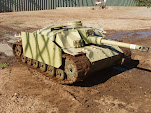Designing an RC tank is not an exact science, a few factors to take into account.
- The scale detail, do you want your tank to look like a replica, or are you happy with reduced detail to speed up construction?
- The performance, race tank? scale speeds? run time? these are all decisions that need to be made before you start designing
- Materials, wood, steel, aluminium? this is usually determined by the workshop facilities you have access to.
Once you know what you want your tank to do, you can start designing. For me this is my favorite process. I use a basic drawing program (coreldraw x4) which lets me get the basic dimensions down in vector format, which also enables me to send plans to laser cutters and other cad type machines.
For this tank I have decided to go all steel and composite materials. Reason being, steel is easy to work with, you can cut, shape, weld and manipulate it relatively easily. Steel also allows the most internal space as you can use thin sheet metal with a limited amount of reinforcement.
I have also decided to get the entire hull lasercut, this ensures a perfect fit with minimal effort required for final Assembly. The biggest con being, the entire tank needs to be designed from top to bottom before sending off your drawings to the cutter, this can take literally hundreds of hours. Worth it in the end though.
Once I had established the hull material its time to look at motors. I want this tank to have about 350-400 RPM at the drive wheel, this gives me roughly 8.5 - 9.5 km/h. As its made of steel, its going to be heavy so I need some beefy drive motors. I came across these (http://www.monsterscooterparts.com/24v-350w-motor-dirt-quad.html) which look perfect for my application. Reasonable price too.
I now know, I need a 24v battery setup, I've chosen to use 4, 12v 12ah sla batteries, this gives me 24v at 24ah which should give me 45-60min run times.
At this stage its also wise to pick any other components you may need to use, speed controllers, RC transmitters, elevate and rotate setup to name a few. (browse through, http://www.robotmarketplace.com/ to find suitable parts)
Setting a speed of 8-9 km/h means this tank is going to be relatively fast, in harsh conditions a tank of this speed with no suspension will tear itself to pieces. So I'm going for a complete suspension setup, each road wheel is independently sprung, this gives a nice smooth ride to protect the delicate electronics, not to mention it looks sweet! (springs and other misc parts can be found here, http://www.mcmaster.com/)
For the tracks I'm going with a "TTS" (Tyng track system) which is basically a belt with "cleats" attached to both sides to form the track. As the tank is suspended, I need to use a sprocket driven track to allow road wheel movement, a friction track can not handle such movement. This system is good because its light, cheap and performs really well. Cons being, labour intensive to build.
More to follow...
=Mr.TigerAce=




















